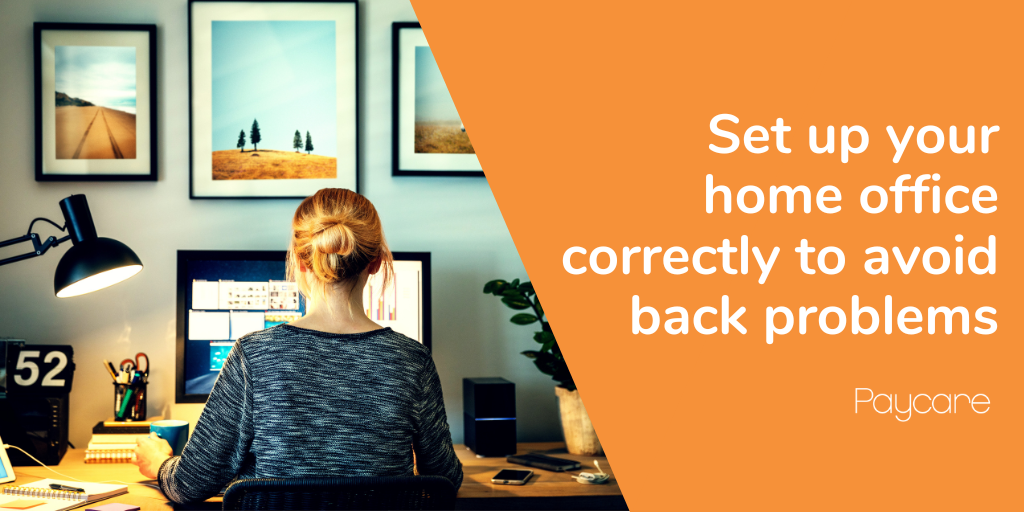Once upon time, working from home was a pipe dream. However, employers are pushing for more flexible work areas in response to the lack of office space, the cost of childcare, and the lengthy commutes. The advances in technology and the passion to create healthy workplaces over the last few years have helped to make this pipe dream a reality for many workers.
So, to support those who work from home regularly, we have shared 4 top tips on how to avoid back problems when setting up your very own office at home!
Take a look!
Whilst there are an abundance of benefits that come with working from home such as organising your work hours to fit in with your schedule, saving money by cutting out petrol spend and public transport costs, and the enjoyment of home luxuries like cooking on your hob or taking breaks in your back garden. With this in mind, it’s possible to overindulge in these home luxuries, the temptation to work from your bed or sofa for instance.
The importance of not entertaining this temptation is not only to prevent you from working in a space that has distractions and decreases productivity, but because your spine is subjected to unnecessary discomfort and encourages unwanted aches and pains in the long run.
When setting up your home office, you should:
- Make careful choices.
When selecting your desired office furniture, choose both aesthetics and practicality. Preferably, an ergonomic chair is the best choice as the piece adjusts to your body shape and size, providing maximum comfort. Next, take the time to find a desk that is solid but not too large, too much space can prompt your body to over-stretch when locating the phone, stationery and documents. Lastly, the HR department at your place of work would carry out an obligatory desk assessment to ensure you don’t strain your spine and eyes, now you will need to make these adjustments yourself to avoid hunching over or craning your neck.
- Laptop users pay attention.
If you’re partial to using a laptop over desktop, be sure to set up your workstation appropriately. For example, even if your desk and chair are at the correct height for you, if you simply place the laptop down on the desk, then you’re likely to still be tilting your head down to see the screen and curving your neck. Invest in a laptop stand that can be raised and adjusted to sit in line with your eye level and purchase a separate keyboard that can be situated on the desk at a comfortable height for your hands.
- Keep active.
Admittedly, cutting out the commute is a winning factor for many of those who choose to work from home, however said commute provides a much-needed break in between looking at your screens at home and the one at work. Depending on what the commute involved – you may have walked or biked in – for many this will have been your main activity for the day. Cutting that out altogether can lead to blurry lines between chilling out at home and working, making it very easy to work too many hours and sit in one spot all day.
Set yourself reminders to get some fresh air in the garden, go for a walk around the block, or head out for lunch to make certain that you take the breaks you need to improve productivity and get in the imperative activity needed to stretch your muscles.
*Top Tip: There are numerous desk yoga and exercises guides out there, enabling you to be active while still sitting at your desk if you can’t get out!*
- Opt for landline phone or headset.
This is only a small change and the best option depends entirely on what is more of an issue for you. Workers who take phone calls often may opt for a landline that provides an alternative to your mobile, therefore you will have to ring instead of texting which involves tilting your head and curving your neck. Whilst others may choose headsets over landlines and mobiles altogether as they steer clear of stretching or reaching when they receive incoming phone calls.”
***
Keeping these 4 tips in mind when setting up your home office should help both your physical health by reducing the level of back and shoulder pain at the end of the day and preventing any long-term issues, but also your mental health. This will help create a clear work space in your home and will decrease stress generated from the lack of organisation without a formal work area at home. Sounds great, right?
Did you know, Chiropractic treatment is covered as standard as part of our Professional Therapies in all of our Health Cash Plans? When combined with a healthy lifestyle, chiropractic is a true wellness enabler! Find out more here!
*Source: Anglia Chiropractic Healthcare.

